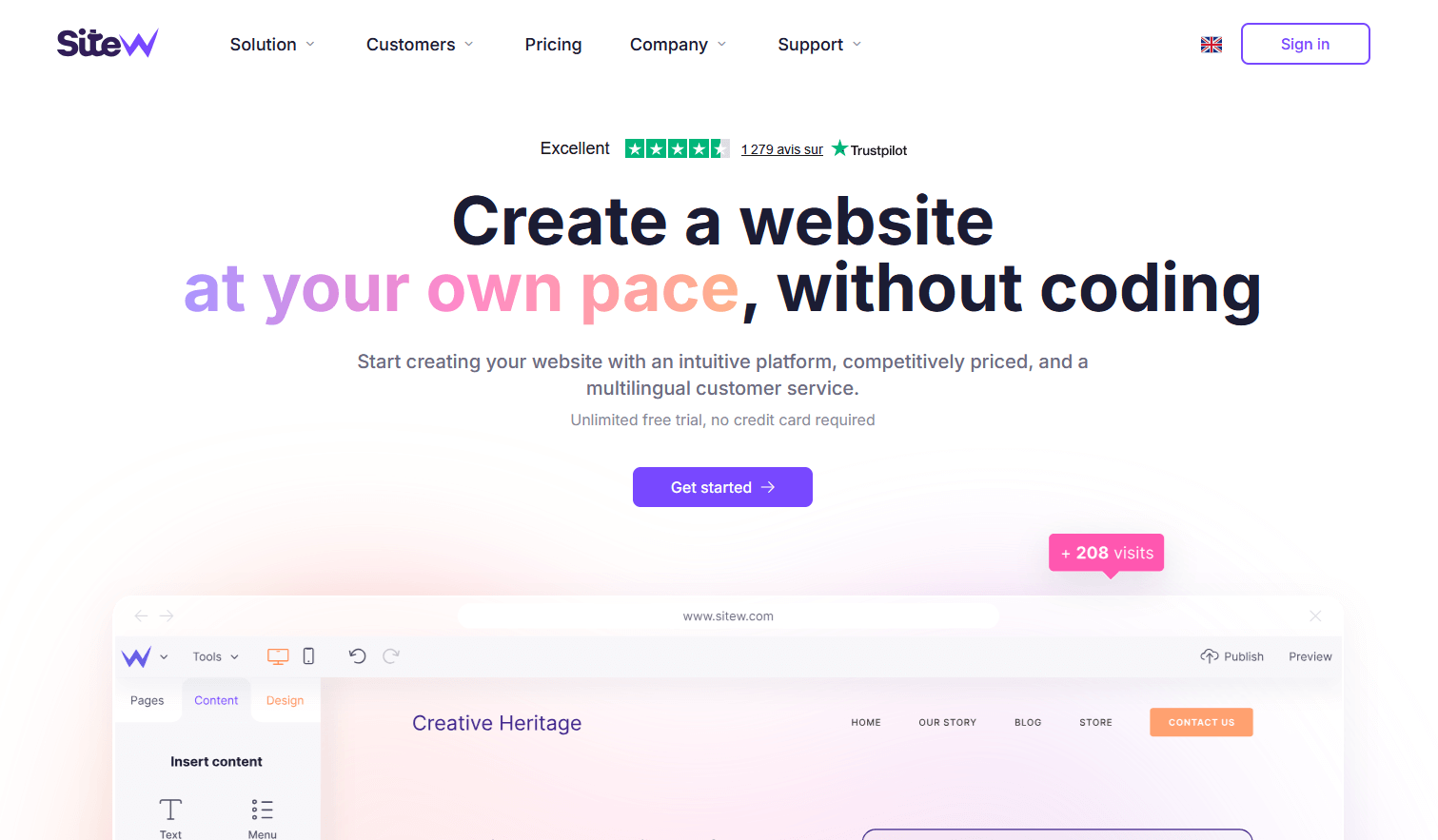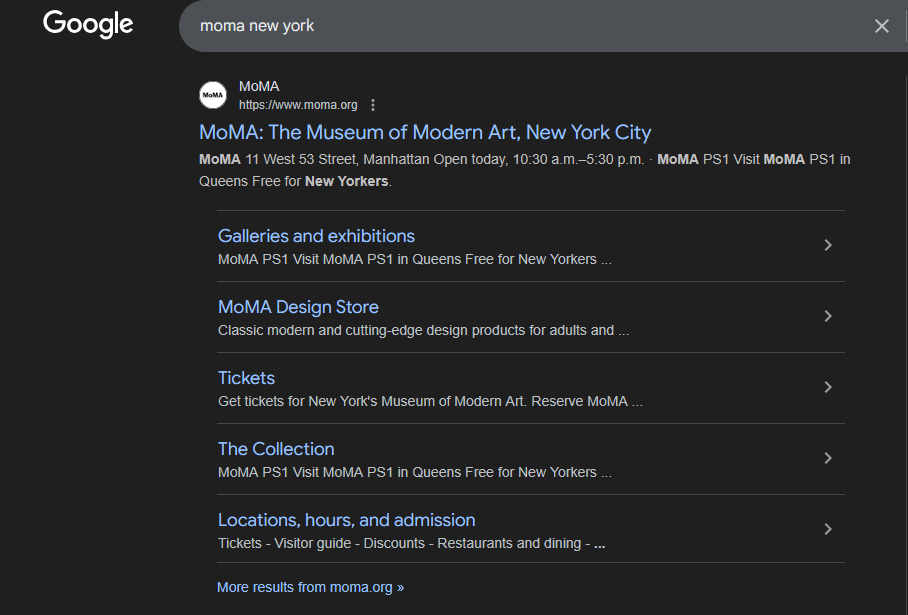GEO/GSO: what are they?
Unlike traditional SEO, which focuses on driving users from search engines to your website, Generative Search Optimization (GSO) is about making sure your content appears within the AI-generated answers users see when they ask questions.
This applies to platforms like Google’s Search Generative Experience (SGE) and Microsoft’s Copilot.
The goal is to help AI systems find, understand, and prioritize your content. In this new search landscape, AI favors direct, context-rich responses over traditional lists of links.
Create a website
The evolution of AI-powered search engines
In just a few years, rapid advances in AI have completely transformed how people search and interact online.
Here is a brief timeline to understand the evolution:
-
November 2022: ChatGPT launches its conversational AI model, setting a new benchmark for natural, dialogue-based search experiences.
-
December 2022: Perplexity debuts, offering answers backed by verifiable web citations — addressing concerns around source attribution and credibility.
-
2023: New players like Claude and LLaMA enter the scene, each bringing unique training data and expanding the AI ecosystem.
-
December 2024: SearchGPT merges large language models with live web indexing, paving the way for hybrid systems that combine trained knowledge with real-time information.
Understanding the different types of AI search model
AI-powered search engines don’t all work the same way — and that impacts how you should optimize for them:
-
Learning-based models (e.g., Claude, LLaMA): These models rely on pre-trained data that doesn’t update in real time. To perform well here, focus on building evergreen, authoritative content that gains trust and relevance over time. ⌛🎓

-
Hybrid models (e.g., Search GPT, Grok, Gemini): These systems blend large language models with live web searches, combining static knowledge with up-to-date information. Optimization here involves a mix of traditional SEO and GEO strategies.
_en.png)
-
Real-time integrated models (e.g., Perplexity, Google AI Overviews): These engines rely heavily on real-time web data, allowing new content to surface almost immediately — making freshness and relevance key optimization factors.

Should you optimize separately for each AI model?
In short — yes. ✅
Each AI platform values different signals, so a one-size-fits-all approach doesn’t work.
Here's a quick overview:
-
Google’s AI still leans heavily on traditional SEO factors, but it also rewards conversational, well-structured content that’s easy for users (and algorithms) to understand.
-
ChatGPT relies on contextual relevance and its training data, so detailed, authoritative content is essential. Real-time data integration varies depending on the version.
-
Perplexity blends live search data with contextual understanding. It tends to favor niche expertise and in-depth publications over broad, general topics.
By keeping up with each platform’s evolution and fine-tuning your content strategy accordingly, you will increase your chances of being mentioned by AI.
GSO (or GEO) vs. traditional SEO: what's the difference?
You may be wondering, “So what's actually new compared to traditional SEO?”
Fair question — after all, GSO and SEO share the same DNA: both aim to boost your online visibility. But the audience and the mechanisms behind them are quite different.
Here’s how optimization for generative search engines differs from traditional SEO 👇
-
Search results vs. conversational answers: Traditional SEO focuses on ranking your page on search engine results with a list of links. GSO, on the other hand, aims to get your content featured within an AI-generated response. Artificial intelligence can synthesize information from dozens of sources.
➡️ In SEO, you fight to be the result ; in GSO, you strive to be part of the answer.
-
Keywords vs. context: SEO traditionally revolves around keyword matching and meta tag optimization. Generative search engines, by contrast, prioritize contextual relevance — using technologies like knowledge graphs to understand meaning and intent. AI models understand natural language and look for content that directly answers questions. This means that clear, factual, conversational writing trumps old-fashioned keyword stuffing.
-
Presence on a page vs. across the web: In traditional SEO, the goal is usually to get an authoritative page ranked for a given term. In AI search, no single page is “ranked” on its own. Artificial intelligence draws on multiple sources (knowledge bases, articles, forums, etc.) simultaneously. This means that it is your overall digital footprint that matters: your website, your blog, your press mentions, Wikipedia entries, Q&A forums in your industry... Anything that AI has been trained on or can retrieve in real time. A solid GSO strategy ensures your brand and content appear across the credible sources that AI systems draw from. (Yes, this means you'll need to work on your content and public relations!)
With GEO, the goal is no longer just to show up on a page, but to become a trusted entity within the AI ecosystem.
To strengthen your digital reputation and digital footprint...
...what better place to start than with a high-quality website!💻👌
And for a professional and effective website, you have SiteW! 🙌
With SiteW, you can create a professional, effective site in no time — just use our AI to generate a custom template, then fine-tune it using our intuitive editor. 🙌
Create a website with AI

-
Ranking signals vs. trust signals: Traditional SEO relies on signals such as netlinking (internal linking and backlinks), page authority, and click-through rates to judge the reliability of content. AI models, on the other hand, are trained on massive datasets and tend to trust well-structured, authoritative information.
Brand authority and factual accuracy are therefore more important than ever
Early data suggests a strong overlap between pages that rank well on Google and those that appear in AI-generated responses. In practice, this means that good SEO lays the foundation for GSO, but GSO goes further: You need to feed AI systems high-quality, verifiable content from sources they already consider trustworthy.
👉 In short, GSO does not replace SEO: it adds a new layer that will need to integrate seamlessly into your workflow. You still need strong traditional SEO, but now you must go a step further, so that AI systems can easily find, interpret, and use your content.
GEO vs. GSO?
Functionally speaking, Generative Engine Optimization (GEO) and Generative Search Optimization (GSO) tackle the exact same goal: getting your brand to show up in AI-powered responses.
Some use the term “engine” to highlight that tools like ChatGPT are more like chatbots than traditional search engines. Others stick with "search" to keep it in line with good old SEO naming. Either way, the terms are pretty much interchangeable.
In any case, both GEO and GSO strategies aim to ensure that AI mentions your brand. 🤷
Will GSO replace traditional SEO?
With all that in mind, you might be wondering if classic SEO is on its way out.
Not a chance - SEO is alive and kicking! GSO and SEO actually work hand in hand. The best approach? Blend them together.
So, definitely don't ditch your site's SEO efforts. Many GSO tactics (like structuring content and building authority) will improve your SEO anyway. And many SEO wins (such as a high Google ranking for a key topic) will in turn increase your chances of being cited by AI.
Combining traditional SEO and AI SEO
In reality, blending classic SEO with AI-focused strategies is key to staying ahead.
This involves:
-
Anticipating user queries: Craft content that answers current and future questions from users by analyzing behavioral data and predictive trends.
-
Writing conversational content: Write in a way that mimics natural conversation, as AI models are trained on conversational data. 💬
-
Adding structured data: Use schema markup so AI can easily retrieve and make sense of your content.
-
Using AI tools for SEO: Leverage the right resources to optimize your content effectively.
_en.png)
Build a high-ranking site with AI
-
Staying agile: Generative models are constantly evolving. Keep a close eye on how your content performs in AI results. And be prepared to adapt if necessary.
-
Tracking performance: Use analytics tools such as Google Search Console. And adapt your strategies accordingly. 📊
Generative Search Optimization : Embracing multimodal search
AI search isn’t just text anymore: they are now capable of understanding and processing other formats. They analyze images, voice commands, and even documents. To remain relevant, brands must improve all their digital resources for multimodal search.
This includes:
-
Optimizing voice search: Make sure your content flows naturally for spoken queries. 📢
-
Boosting image SEO for AI: Add smart alt text and metadata so machines can “see” your visuals. 🖼️
-
Adapting to multimodal search: Expand your strategy to cover different formats and media types.
-
Optimizing every asset: Videos, audio, documents…, optimize them all for better visibility in AI-powered results. 📷🎥
New metrics for measuring GSO success
Traditional SEO metrics, such as keyword rankings and organic traffic, do not fully reflect AI search performance.
GEO success is measured by:
-
Brand visibility: Track mentions of your brand across platforms and AI responses.
-
AI mentions: Count how frequently your content or brand gets name-dropped in AI outputs.
-
Opportunity spotting: Figure out which AI tools your audience uses and pinpoint where you could show up.
-
Search volume for your brand: Monitor increases in direct searches for your brand, as this may indicate that users are searching for your content directly after interacting with AI tools.
☝️ These metrics require new tracking tools and strategies, as they go beyond what traditional SEO dashboards typically provide.
How to build your GEO strategy?
In short, to stay competitive in the age of AI-driven search, companies need to:
-
Create high-quality, in-depth content that answers complex questions and showcases expertise. ✍️
-
Add structured data so AI models can easily crawl and interpret their content.

-
Track their brand’s visibility and mentions across platforms and AI responses.
-
Monitor new metrics like AI citations, brand-related search volume, and emerging opportunities.
-
Adapt to the unique characteristics of each AI engine by tailoring their content strategy to updates and data sources used.
-
Prioritize user experience to boost the engagement signals that AI models use to evaluate content value.
Concrete tactics to implement to optimize search via AI
Optimizing for generative search blends technical SEO tweaks, smart content strategies, and solid brand building.
Here are some tips to get started:
1. Structure your content with AI in mind: AI thrives on clear, digestible formats. so, use clear headings, bullet points, and FAQs to break down information. For example, add a section in your blog posts tackling the top questions in your niche. Including a brief summary at the end of your articles can also provide AI with a ready-to-use excerpt. As a general rule, anticipate the questions AI might answer and make sure your content answers it directly.
2. Provide comprehensive, factual answers: Try to create content that AI would love to cite - neutral, accurate, and thorough.
For example, if you want AI to mention your flagship product, make sure this information is clearly available on an authoritative page (press release, Wikipedia, your About page, etc.). The goal is to become a reliable source in your field.
Pro tip
Contribute to industry reports or get quoted in reputable publications: these citations can filter into the AI knowledge base and strengthen your authority.
3. Use schema markup and metadata: Just as you would add structured data for Google, do the same for AI. Schema markup helps convey the context of your content in a machine-readable way. Similarly, make sure your titles and meta descriptions (= text intended for search engines) are clear and factual.

4. Publish on trusted and high-authority platforms: Don't limit yourself to your own blog. As we mentioned, AI responses are often synthesized from multiple sources. If your brand or ideas appear on Wikipedia, industry wikis, reputable forums, or government/educational sites, it carries weight. For example, if a relevant question is asked on a Q&A platform, try to contribute to the discussion in a qualitative way. These are the breadcrumbs that AI models pick up during training or real-time exploration. Also, make sure your business profiles (Google Business, etc.) are up to date.
5. Optimize for natural, conversational queries: People talk to AI like friends. So identify the most common types of queries in your field. You can brainstorm with your team: what would you ask an AI about your product or service? Then create content (blog posts, videos, etc.) around these questions. Better yet, use your site's FAQ page to answer them directly.
6. Keep your content up-to-date and relevant: One of the challenges with chatbots like ChatGPT is that their training data may be a year or two old. If your content is very recent, some AI models may not “see” it. To fill this gap, update key pages with new statistics or information. Mix evergreen authority pieces with timely updates - don't let your site or online mentions gather dust.
7. Monitor and fix brand info in AI responses: Test what AI says about you by querying bots directly. Spot errors (like outdated features or missing details)? That's a cue to create content clarifying those points. You can publish a blog post titled “Myths and Realities” or update your “About” page to explicitly correct the information. Although you can't edit AI outright, you can influence future results by feeding the web with accurate, well-referenced information.

Optimizing for generative engines is not just the next step in SEO, it’s a full-on paradigm shift in how content gets found, highlighted, and evaluated online.
With AI-powered search, businesses need to rethink their marketing strategies to focus on brand visibility, authority, and AI ecosystems.
Traditional SEO still matters, but GEO requires a broader approach that includes feeding generative models with rich, structured, and reliable content that teaches the models who you are. Tracking new metrics like AI mentions and brand visibility across different platforms will give you a better understanding of your performance in this new world.
As this technology evolves, staying curious and agile will be your greatest asset. Embrace change, optimize smartly, and always keep your audience front and center. 🚀

_en.png)




_en.png)



